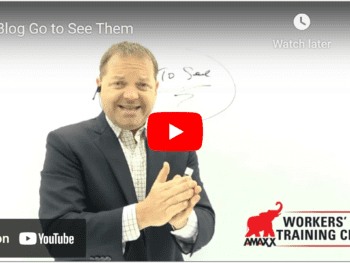Have ever been watching a sports game whether on TV or in person, and you see and feel the momentum shift? The team with the positive momentum can’t seem to do anything wrong. And the team with the negative momentum can’t seem to do anything right.
Hello, my name is Michael Stack, CEO of AMAXX, and this concept of momentum I believe is the most underrated and powerful force in our world today. And if we can harness this power of momentum, and if we can understand it and apply it to our work comp programs, the benefits can be immeasurable.
Positive or Negative Starts At First Reaction from Supervisor
How this plays out is really right at the start of that claim. That interaction between the employee and the supervisor. That’s going to set the tone for how the entire claim is going to go. So, you need to train your supervisors on how to respond accordingly. And the good part is, it’s really not that difficult. There’s a couple of simple steps that they need to do, that they need to take, that they need to have the right mindset in how to respond to those injuries, that can start building that positive momentum in your favor.
Click Link to Access Free PDF Download
“9-Element Blueprint To Create Your Workers’ Comp Employee Brochure”
Step #1: Demonstrate Care
So let’s talk about hat these couple of simple steps are. First thing the supervisor needs to do is demonstrate care. First thing they need to do is demonstrate care. How are you feeling? I’m sorry you got injured. Is there anything I can do to help? And then listen and problem solve. Again, listen and problem solve. Very simple as far as responding to their injury. Demonstrate care.
Step 2: Set Expectations
Next piece here, set expectations. Set expectations for what’s going to happen, and how this work comp program is going to work for that employee, answering some of these simple questions, like how is the employee going to get paid? Are they going to be able to return to work? How is that all going to work. And then how is the medical treatment going to work? How are they going to get their treatment? What doctor are they going to be able to see? How are they going to get their prescriptions filled? Are they going to have to pay a deductible?
I heard a lot of stories from my cousin that got injured, and that didn’t really go to well for him. So, set those expectations, answer those questions. Really let them know what’s going to happen.
Step 3: Facilitate Medical Care with Injury Triage
And then the final thing is facilitating the medical care. Coordinating and facilitating that medical care. And the best practice here is to really make this very simple for your supervisors, but I’m just going to guess they’re probably not trained as medical professionals. They probably don’t know exactly what to do with a shoulder injury. Leverage a third part injury triage provider. Have that supervisor and that employee call the nurse hotline together. They’ve walked through millions of calls on how to handle that shoulder injury, and they can get to that individual employee to the right treatment in the right time frame.
Very simple steps for your supervisors to follow at the time of injury, that can build that positive momentum for that claim. Again, my name is Michael Stack, CEO of AMAXX. And remember, your work today in workers compensation, it can have a dramatic impact on your company’s bottom line. But it will have a dramatic impact on someone’s life. So, be great.

Author Michael Stack, CEO Amaxx LLC. He is an expert in workers’ compensation cost containment systems and helps employers reduce their workers’ comp costs by 20% to 50%. He works as a consultant to large and mid-market clients, is a co-author of Your Ultimate Guide To Mastering Workers Comp Costs, a comprehensive step-by-step manual of cost containment strategies based on hands-on field experience, and is founder & lead trainer of Amaxx Workers’ Comp Training Center .
Contact: mstack@reduceyourworkerscomp.com.
Workers’ Comp Roundup Blog: https://blog.reduceyourworkerscomp.com/
©2018 Amaxx LLC. All rights reserved under International Copyright Law.
Do not use this information without independent verification. All state laws vary. You should consult with your insurance broker, attorney, or qualified professional.















